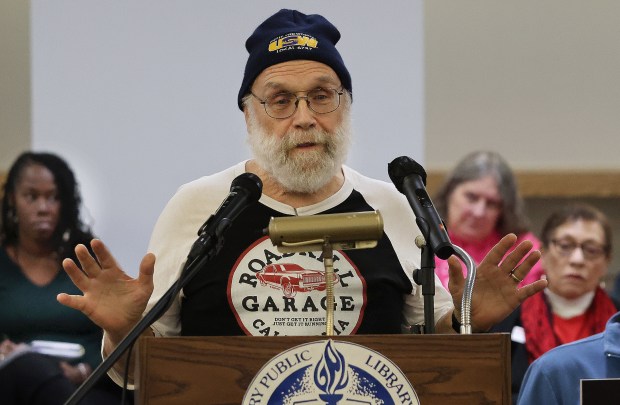Carla Cherry might be just one person in the community, but she speaks for more. She speaks for her brother receiving disability payments, her husband who just retired, and her church that can hardly keep the doors open.
“Don’t stand for a corporation that’s got money and investors — stand for us,” Cherry on Thursday night told members of the Indiana Utility Regulatory Commission. “I need to be able to go home and turn on my lights after working all day. I need to be able to go to sleep in a warm house without worrying about if I’m going to starve to death to pay that bill.”
Cherry was one of more than 20 speakers — including activists, community members and a former NIPSCO employee — who spoke in opposition of the proposed NIPSCO electric rate increase. The 22% electric rate increase would cost NIPSCO’s typical residential customers an additional $32 each month, according to the utility, but the Citizens Action Coalition says the increase is more like $45, according to Post-Tribune archives.
The IURC has held multiple public field hearings — in Valparaiso and Hammond as well as the one Thursday night at the Carter G. Woodson branch of the Gary Public Library. About 100 people attended the hearing, with very few seats left for residents.
The Gary hearing was the final for Northwest Indiana residents, and community members on Thursday voiced their concerns for more than two-and-a-half hours.
The IURC is expected to make its decision in the summer of 2025, after various testimonies, hearings and briefs.

The Indiana Office of the Utility Consumer Counselor on Dec. 19 plans to offer its recommendations on NIPSCO’s rate request.
The public comment deadline is Dec. 12, according to the IURC. People can submit comments online at in.gov/oucc/2361.htm and by mail at Public Comments, Indiana Office of Utility Consumer Counselor, 115 W. Washington St. Suite 1500 South, Indianapolis, IN 46204.
NIPSCO is undergoing an electric generation transition that it says will provide direct benefits to customers and communities, according to information from the utility. If approved by the IURC, the rates will support infrastructure and system upgrades.

If approved, the rate change would begin by Sept. 1, and the remaining changes applied by March 2026, according to NIPSCO.
The utility serves 1.3 million customers across northern Indiana, including 500,000 electric customers, according to its website.
Although NIPSCO says the rate increase will help its system, community members have concerns about affordability, especially for those on a fixed income.

Mattie Perry-Lightfoot, who lives on a fixed income, said her Social Security and Medicare bills increased, and her other bills are high.
“In my household, I try to keep my lights off when they’re not needed,” Perry-Lightfoot said. “I try to do everything to lower my electric and gas bills, but it seems the more I do that, the more increases are being put through.”
Perry-Lightfoot is also upset about the rate increase because she experiences multiple outages each year, she said. Other speakers also voiced their concerns about outages.

Paul Kaczocha, a 73-year-old retired steelworker, said he lost power eight times from August 2023 to August 2024. On Wednesday, Kaczocha was worried he would lose power because wind speeds were high and temperatures were low.
“I was worried all night,” he said. “It didn’t happen, thank goodness, but nonetheless, this rate increase is going to affect those of us on fixed incomes.”
Kaczocha was concerned with NIPSCO increasing rates to fund projects, he said, especially when looking at executives’ salaries. In 2023, Lloyd Yates, president and CEO of NiSource — who owns NIPSCO — made about $9.2 million, according to salary.com.
Carolyn McCrady, a Gary resident, asked how rising costs are good for customers. She asked the commission to think about communities that the rate increase would hurt.
“Gary, Indiana, has the highest unemployment rate in the state, the highest poverty rate and the lowest median household income,” McCrady said. “How will so many Gary residents be able to pay these exorbitant costs? And then again, why should we?”
Susan Thomas, director of legislation and policy at Just Transition Northwest Indiana, called NIPSCO’s rate increase predatory and said it impacts communities’ most vulnerable residents, including senior citizens and children.
Thomas’ NIPSCO bill is close to $400, she said, and if the rate increase is passed, she will have to “make real budgeting decisions.”
Thomas is also concerned about NIPSCO’s environmental impact. NIPSCO had coal ash ponds at the Michigan City Generating Station, which the utility began to close in spring 2022.
Coal ash is produced primarily from burning coal in power plants, according to the Environmental Protection Agency.
Thomas also believes NIPSCO has no plan for renewable energy, which she called concerning.
“The IURC shouldn’t continue to allow these corporate predators … laugh all the way to the bank while our most vulnerable Hoosier populations suffer,” she said. “You are responsible. Do not allow this egregious request.”
Multiple other speakers also asked the IURC to stick up for community members and not pass the rate increase.
Shaw Friedman, a LaPorte resident and lawyer, said he previously worked as an attorney for the Citizens Action Coalition and helped win a case that returned $500 million to customers. Friedman has watched the IURC block deals before, he said, and he knows they can do it again.
“Unfortunately, in recent years, the commission has gotten a bit of a reputation as being overly sympathetic to the investor-owned utilities,” Friedman said. “It is time for this commission to task its staff … with coming up with creative ways to help lessen the burden on average residential and commercial rate payers who can’t afford these confiscatory rates any longer.”
Jennifer Williams, a Hobart resident and former NIPSCO employee, also spoke out against the rate increase. Williams mentioned that she knows two unions are against the rate hike, even though it could potentially impact their salaries and bonuses.
Williams also shared how much her NIPSCO bill cost, which is more than $200. She knows people who live around her that pay nearly $400 each month, Williams said.
“We cannot keep on doing the people of our cities and towns of money that’s not there,” she said. “It’s getting to the point where the rich can’t even rob from the poor because there’s nowhere to rob from.”





